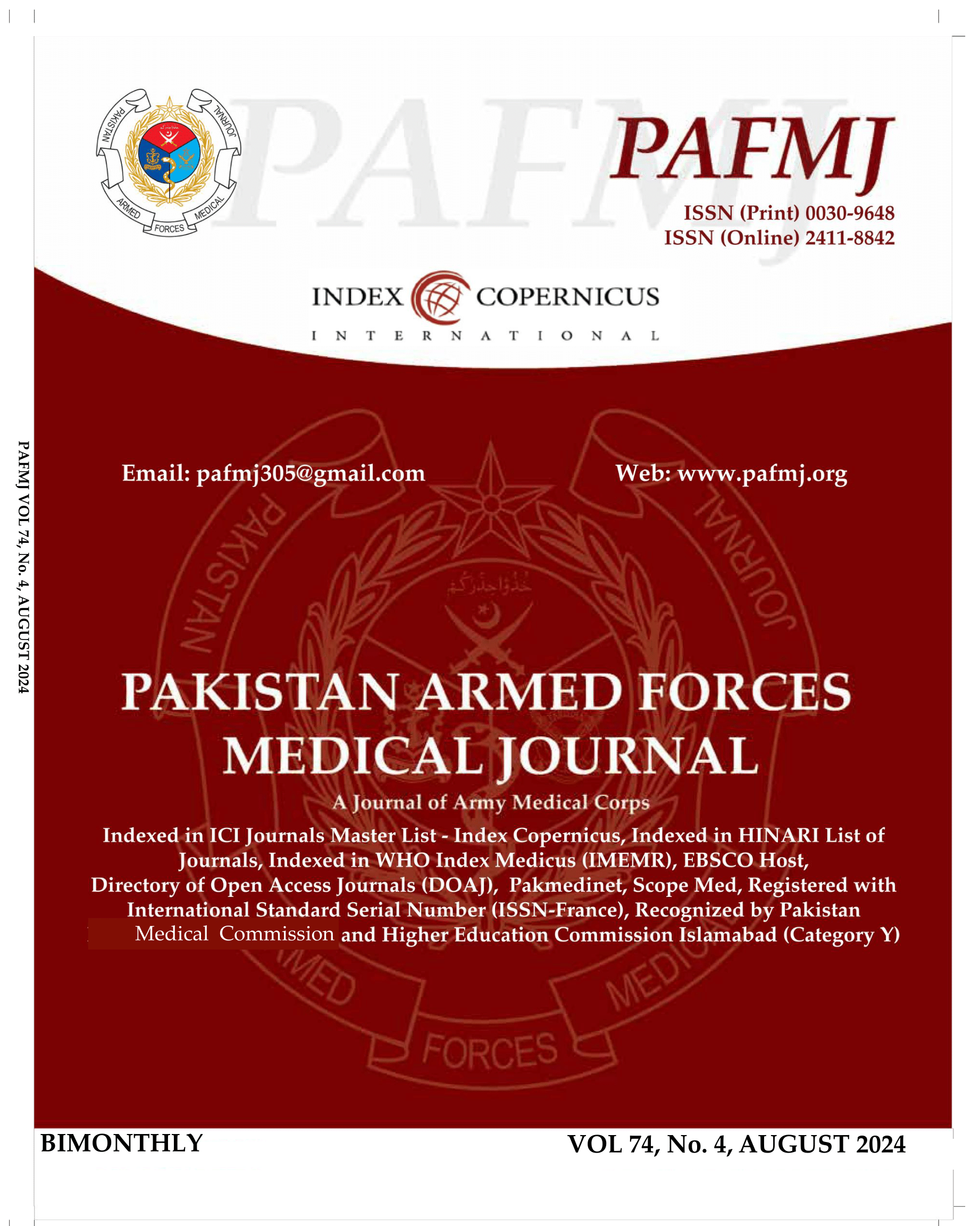Common Pathogens and their Antimicrobial Susceptibility Pattern in Urinary Tract Infection Among Spinal Cord Injury Cohort
DOI:
https://doi.org/10.51253/pafmj.v74i4.10376Keywords:
Antimicrobial susceptibility, Nosocomial infections, Rehabilitation medicine, Spinal cord injuryAbstract
Objective: To determine the frequency of nosocomial urinary tract infections in patients admitted for spinal cord injury rehabilitation, identify the organisms responsible, and determine their susceptibility to systemic antimicrobials.
Study Design: Cross-sectional study.
Place and Duration of Study: Armed Forces Institute of Rehabilitation Medicine, Rawalpindi Pakistan, from Sep 2022 to Apr 2023.
Methodology: Samples for urine culture and sensitivity were taken from 47 individuals; 25 of these were excluded due to the growth of mixed organisms. Both male and female patients were included with Spinal Cord injury and admitted to the Inpatient Department for rehabilitation. Spinal cord injuries were classified as acute (<6 months) and chronic (>six months), depending upon the time elapsed since the injury. Symptoms of urinary tract infections were documented.
Results: The sample showed a male preponderance, with 18(81.80%) males and 4(18.20%) females. Twelve individuals (54.5%) had symptoms of urinary tract infection. The urine sample yielded microbial growth in 19(86.40%) samples, confirming the diagnosis of UTI. Out of the participants, 9(40.90%) had acute SCI, while 13(59.10%) had chronic SCI. The mean duration since the SCI was 8.04±5.84 months.
Conclusion: In patients with urinary tract infections associated with spinal cord injury, Klebsiella and Escherichia coli were found to be the major causative organisms. Meropenem, Fosfomycin, and Gentamicin were found to be the most effective initial choice of antibiotics, exhibiting increased sensitivity against the alleged microorganisms.
Downloads
References
Salh KK. Antimicrobial Resistance in Bacteria Causing Urinary Tract Infections. Comb Chem High Throughput Screen. 2022; 25(7): 1219-1229.
https://doi.org/10.2174/1386207324666210622161325
Forster CS, Pohl H. Diagnosis of Urinary Tract Infection in the Neuropathic Bladder: Changing the Paradigm to Include the Microbiome. Top Spinal Cord Inj Rehabil 2019; 25(3): 222-227.
https://doi.org/10.1310/sci2503-222
Herrity AN, Castillo C, Isakov RV, Anele UA, Wang D, Boakye M, et al. Health Care Utilization and Cost Associated With Urinary Tract Infections in a Privately Insured Spinal Cord Injury Population. Top Spinal Cord Inj Rehabil 2023; 29(1): 108-117. https://doi.org/10.46292/sci22-00022
Jeffries MA, Tom VJ. Peripheral Immune Dysfunction: A Problem of Central Importance after Spinal Cord Injury. Biology 2021 ;10(9):928.
https://doi.org/10.3390/biology10090928
Henderson JT, Webber EM, Bean SI. Screening for Asymptomatic Bacteriuria in Adults: Updated Evidence Report and Systematic Review for the US Preventive Services Task Force. JAMA 2019; 322(12): 1195-1205.
https://doi.org/10.1001/jama.2019.10060
Kalsi-Ryan S, Kapadia N, Gagnon DH, Verrier MC, Holmes J, Flett H, et al. Development of Reaching, Grasping &
Manipulation indicators to advance the quality of spinal cord injury rehabilitation: SCI-High Project. J Spinal Cord Med 2021; 44(sup1): S134-S146.
https://doi.org/10.1080/10790268.2021.1961052
Davis M, Jethani L, Robbins E, Kaner M. Is It Really the Foley? A Systematic Review of Bladder Management and Infection Risk. Top Spinal Cord Inj Rehabil 2023; 29(1): 94-107.
https://doi.org/10.46292/sci22-00009
Yan L, Ge H, Zhang Y, Li N. Epidemiology of pathogens and antimicrobial resistance of nosocomial urinary tract infections in patients with spinal cord injuries in China: A systematic review and meta-analysis. J Spinal Cord Med 2023: 1-17.
https://doi.org/10.1080/10790268.2022.2129154
Mahboob F, Ahmed N, Rathore F, Razzaq S. Frequency of Uri- nary Tract Infection (UTI) & Commonest Causative Organisms in Spinal Cord Injury Patients With Various Voiding Modes. Pak Armed Forces Med J 2011; 61(3): 89-94.
Ali S, Naqvi S, Butt A. Nosocomial urinary tract infections, and their susceptibility to antimicrobial agents in spinal cord injury patients at a rehabilitation setting. Pak Armed Forces Med J 2021; 71(2): 464-468.
https://doi.org/10.51253/pafmj.v71i2.2937
Leoni MEG, De Ruz E. Management of urinary tract infection in patients with spinal cord injuries. Clin Microbiol Infect 2003; 9(8): 780–785.
https://doi.org/10.1046/j.1469-0691.2003.00643.x
Ishida S, Matsukawa Y, Yuba T, Naito Y, Matsuo K, Majima T, et al. Urodynamic risk factors of asymptomatic bacteriuria in men with non-neurogenic lower urinary tract symptoms. World J Urol 2022; 40(12): 3035-3041.
https://doi.org/10.1007/s00345-022-04194-x
Yilmaz B, Yavuz F, Adigüzel E. Retrospective analysis of noso- comial urinary tract infections with spinal cord injury patients in a rehabilitation setting. Turk J Phys Med Rehab 2014; 60(2): 289-294.
Tessema NN, Ali MM, Zenebe MH. Bacterial associated urinary tract infection, risk factors, and drug susceptibility profile among adult people living with HIV at Haswassa University Comprehensive Specialized Hospital, Hawassa, Southern Esthiopia. Sci Rep 2020; 10(1): 10790.
https://doi.org/10.1038/s41598-020-67840-7
Stamm WE. Catheter-associated urinary tract infections: epidemiology, pathogenesis, and prevention.Am J Med 1991: 91(3B), 65S–71S.
https://doi.org/10.1016/0002-9343(91)90345-x
Penders J, Huylenbroeck AA, Everaert K, van Laere M, Verschraegen GL. Urinary infections in patients with spinal cord injury. Spinal Cord 2003; 41(10): 549–552.
https://doi.org/10.1038/sj.sc.3101499
Health Quality Ontario. Intermittent Catheters for Chronic Urinary Retention: A Health Technology Assessment. Ont Health Technol Assess Ser 2019; 19(1): 1-153.
Nejad BS, Allegranzi B, Syed SB, Ellis B, Pittet D. Health-care-associated infection in Africa: a systematic review. Bull World Health Organ 2011; 89(10): 757-765.
Downloads
Published
Issue
Section
License
Copyright (c) 2024 Waqas Khalil, Omer Jamshed, Hina Kanwal, Talha Liaqat, Tameem ul Hassan, Fahad Hasnain

This work is licensed under a Creative Commons Attribution-NonCommercial 4.0 International License.















